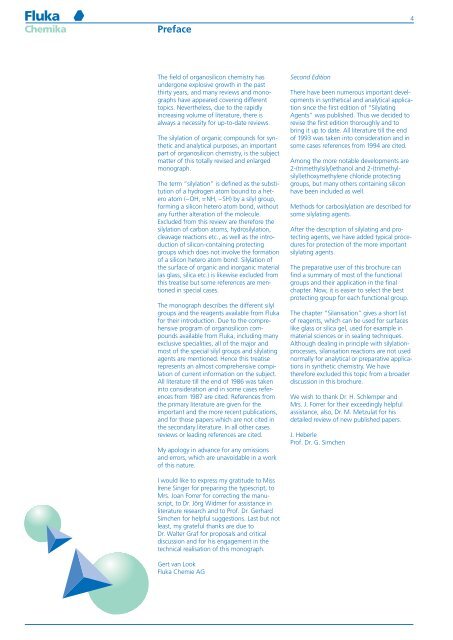Fluka - Sigma-Aldrich
Fluka - Sigma-Aldrich
Fluka - Sigma-Aldrich
Create successful ePaper yourself
Turn your PDF publications into a flip-book with our unique Google optimized e-Paper software.
<strong>Fluka</strong><br />
Chemika<br />
Preface<br />
The field of organosilicon chemistry has<br />
undergone explosive growth in the past<br />
thirty years, and many reviews and monographs<br />
have appeared covering different<br />
topics. Nevertheless, due to the rapidly<br />
increasing volume of literature, there is<br />
always a necessity for up-to-date reviews.<br />
The silylation of organic compounds for synthetic<br />
and analytical purposes, an important<br />
part of organosilicon chemistry, is the subject<br />
matter of this totally revised and enlarged<br />
monograph.<br />
The term “silylation” is defined as the substitution<br />
of a hydrogen atom bound to a hetero<br />
atom (–OH, =NH, –SH) by a silyl group,<br />
forming a silicon hetero atom bond, without<br />
any further alteration of the molecule.<br />
Excluded from this review are therefore the<br />
silylation of carbon atoms, hydrosilylation,<br />
cleavage reactions etc., as well as the introduction<br />
of silicon-containing protecting<br />
groups which does not involve the formation<br />
of a silicon hetero atom bond. Silylation of<br />
the surface of organic and inorganic material<br />
(as glass, silica etc.) is likewise excluded from<br />
this treatise but some references are mentioned<br />
in special cases.<br />
The monograph describes the different silyl<br />
groups and the reagents available from <strong>Fluka</strong><br />
for their introduction. Due to the comprehensive<br />
program of organosilicon compounds<br />
available from <strong>Fluka</strong>, including many<br />
exclusive specialities, all of the major and<br />
most of the special silyl groups and silylating<br />
agents are mentioned. Hence this treatise<br />
represents an almost comprehensive compilation<br />
of current information on the subject.<br />
All literature till the end of 1986 was taken<br />
into consideration and in some cases references<br />
from 1987 are cited. References from<br />
the primary literature are given for the<br />
important and the more recent publications,<br />
and for those papers which are not cited in<br />
the secondary literature. In all other cases<br />
reviews or leading references are cited.<br />
My apology in advance for any omissions<br />
and errors, which are unavoidable in a work<br />
of this nature.<br />
I would like to express my gratitude to Miss<br />
Irene Singer for preparing the typescript, to<br />
Mrs. Joan Forrer for correcting the manuscript,<br />
to Dr. Jörg Widmer for assistance in<br />
literature research and to Prof. Dr. Gerhard<br />
Simchen for helpful suggestions. Last but not<br />
least, my grateful thanks are due to<br />
Dr. Walter Graf for proposals and critical<br />
discussion and for his engagement in the<br />
technical realisation of this monograph.<br />
Gert van Look<br />
<strong>Fluka</strong> Chemie AG<br />
Second Edition<br />
There have been numerous important developments<br />
in synthetical and analytical application<br />
since the first edition of “Silylating<br />
Agents” was published. Thus we decided to<br />
revise the first edition thoroughly and to<br />
bring it up to date. All literature till the end<br />
of 1993 was taken into consideration and in<br />
some cases references from 1994 are cited.<br />
Among the more notable developments are<br />
2-(trimethylsilyl)ethanol and 2-(trimethylsilyl)ethoxymethylene<br />
chloride protecting<br />
groups, but many others containing silicon<br />
have been included as well.<br />
Methods for carbosilylation are described for<br />
some silylating agents.<br />
After the description of silylating and protecting<br />
agents, we have added typical procedures<br />
for protection of the more important<br />
silylating agents.<br />
The preparative user of this brochure can<br />
find a summary of most of the functional<br />
groups and their application in the final<br />
chapter. Now, it is easier to select the best<br />
protecting group for each functional group.<br />
The chapter “Silanisation” gives a short list<br />
of reagents, which can be used for surfaces<br />
like glass or silica gel, used for example in<br />
material sciences or in sealing techniques.<br />
Although dealing in principle with silylationprocesses,<br />
silanisation reactions are not used<br />
normally for analytical or preparative applications<br />
in synthetic chemistry. We have<br />
therefore excluded this topic from a broader<br />
discussion in this brochure.<br />
We wish to thank Dr. H. Schlemper and<br />
Mrs. J. Forrer for their exceedingly helpful<br />
assistance, also, Dr. M. Metzulat for his<br />
detailed review of new published papers.<br />
J. Heberle<br />
Prof. Dr. G. Simchen<br />
4

















